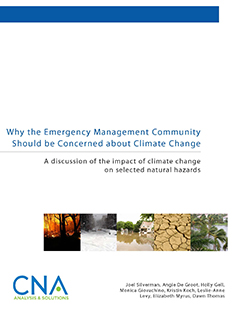A discussion of the impact of climate change on selected natural hazards
Increases in the concentrations of atmospheric greenhouse gases from activities such as burning fossil fuels and deforestation have caused a measurable increase in global temperatures. As greenhouse gas concentrations continue to increase, further changes in the Earth’s climate are expected. These changes may impact the location, frequency, and occurrence of natural hazards such as tropical cyclones, wildfires, floods, and winter storms. Thus, the historical data that are typically the basis of hazard identification and risk assessment may not accurately forecast future events. Consequently, we need to begin to evaluate and better understand how climate change could affect the identification and selection of disaster mitigation strategies, the types of preparedness activities that jurisdictions undertake, the execution of response operations, and the implementation of long-term recovery strategies.
This report is one of several reports from CNA examining the impact of climate change on U.S. policy. This particular report focuses on the impact of climate change on comprehensive emergency management and preparedness policy. It seeks to outline key climate change issues for consideration from an emergency management perspective and begin a conversation on potential implications for the near-, medium-, and long-terms. It lays the foundation for future dialogue among emergency management practitioners from all levels of government to explore policy solutions in greater depth. The scientific foundation for much of the discussion in this report comes from the recently published report from the U.S. Global Change Research Program— Global Climate Change Impacts in the United States.
IMPACT OF CLIMATE CHANGE ON HAZARDS
We identified several natural hazards that are both of significant interest to the emergency management community and are expected to be impacted by climate change, including tropical cyclones1, floods, wildfires, winter storms, heat waves, and foodborne and waterborne disease outbreaks. Figure 1 summarizes the predicted impacts of climate change on hazards by region in the United States. The climate change literature indicates that all regions of the U.S. may be susceptible to an increase in frequency and/or severity of flooding and foodborne and waterborne disease outbreaks. Other climate-induced changes are predicted only in certain regions.
We used the familiar Federal Emergency Management Agency (FEMA) regions to depict the impact of climate change. However, there are several hazards that may impact different segments of a FEMA region differently, or where an increased likelihood of a hazard may span multiple FEMA regions.
This document was prepared by CNA under a grant from the Rockefeller Foundation. This document represents the best
opinion of CNA at the time of the issue. It does not necessarily represent the opinion of the Rockefeller Foundation.
Details
- Pages: 48
- Document Number: IIM-2017-U-016078-Final
- Publication Date: 12/1/2010
